

The Search for Dark Matter
Pictures of the universe always fascinate me. The scale is beyond comprehension. The universe is filled with gas, dust, rocks, planets, stars, galaxies and superclusters, as far as our telescopes can see.
The amount of "stuff" in the universe defies measurement, but for decades scientists have tried. Now they have proposed that as much as 95% of the stuff in the universe is invisible -- cannot be seen, measured or detected.
Called "dark matter" because it neither absorbs, radiates or reflects light, this anomalous stuff continues to baffle physicists who can confirm its existence but offer only diverse theories about its composition. Aside from curiosity, scientists realize that the existence of dark matter will determine the ultimate shape and destiny of the universe.
Without requiring a degree to understand it, here are some basic and simplified facts on the history and current status of dark matter.
The Anomaly of Galactic Rotation
One of the first clues that our cosmology of the universe was wrong came when astronomers were able to measure the velocity of stars in the rotating discs and halos of neighboring galaxies, at various distances from the center bulge and the plane of the disc.
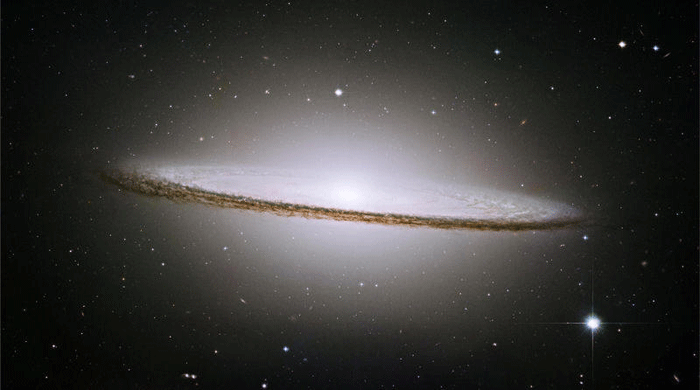
Most galaxies, like our own Milky Way, are disc shaped with a concentration of visible stars in the "bulge" at the center. Scientists equate the brightness of stars with their mass. By measuring the brightness and number of stars in a galaxy, they are able to estimate the total mass of the galaxy and, by observation, most of the mass is in the central bulge. They assumed that this central mass would pull on the surrounding stars, causing the whole galaxy to rotate, much as our massive Sun causes the planets to orbit.
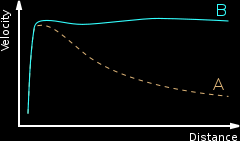 Like our Sun, the gravitation pull of the mass diminishes with the distance of the rotating bodies (planets) causing the nearer ones to have a greater velocity than the distant ones. This is shown on the graph [right] as path A. But what they observed was actually a constant velocity, shown in path B.
Like our Sun, the gravitation pull of the mass diminishes with the distance of the rotating bodies (planets) causing the nearer ones to have a greater velocity than the distant ones. This is shown on the graph [right] as path A. But what they observed was actually a constant velocity, shown in path B.
Further, objects not in the disc, but in the halo of the galaxies, also moved at the same constant velocity. The cumulative solar masses of all the stars just could not account for this so it was decided that there must be some "unseen" (hence dark) matter which had a gravitational effect but did not react electromagnetically, did not absorb or reflect light and did not react chemically. It was invisible to every measurement except gravity.
At first, calculations of how much dark matter there was in the universe were conservative. Over the last few years the estimates have grown from 15% to the current estimate of 95%. And soon more evidence of the existence of dark matter was to come.
The Lens Effect
In Einstein's theory of relativity, space itself seems to bend in the presence of mass. So, even though light particles are traveling in straight lines, the curved space distorts the angle of view with light arriving at the observer from many paths, instead of just one.
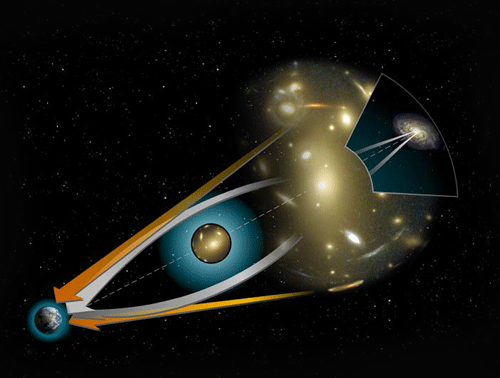
For the effect to work, the mass of the obscuring object must be huge -- capable of bending space. Experimentally, the effect has been observed with distant galaxies and with our own sun, enabling astronomers to calculate the mass of the object creating the distortion. But when the effect was observed in a huge galactic cluster, the estimated mass was much too small to create the distortion. Something weird was happening. Scientists ask, "Where's the mass?"
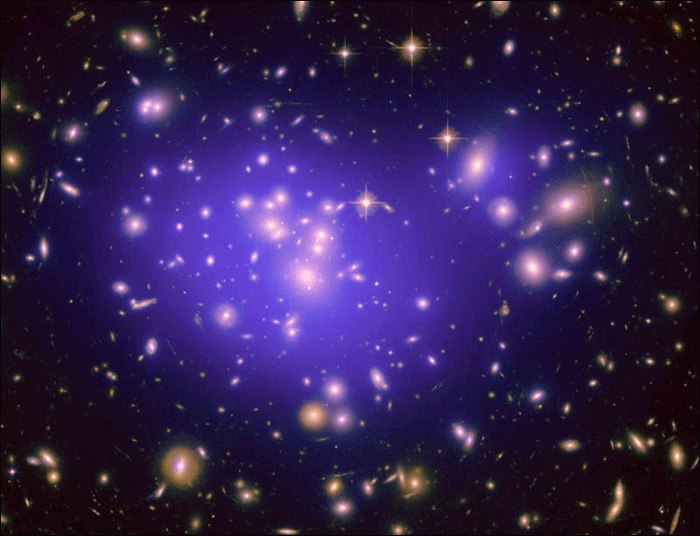
One of the classic examples of evidence for dark matter comes from observations of a huge cluster of galaxies -- over a hundred, each as big or bigger than our Milky Way -- called Abell-1689 [above]. If you look closely, you will see that there are several galaxies that appear to be curved, creating an effect not unlike the headlights of a car through a scratched windshield. Astronomers were puzzled by this until they realized that the distorted galaxies were images of distant galaxies behind the cluster, their light being bent as it was distorted by the cluster's gravity.
Examination of the cluster failed to show enough mass to cause this. As big as they are, the estimate of all the solar masses still should not have been capable of such a feat. It was not until NASA's Chandra X-ray Telescope imaged the emissions from extremely hot gas [overlay in blue color] that they realized the entire cluster was contained inside a cloud of "something". Current understanding attributes this "something" to dark matter.
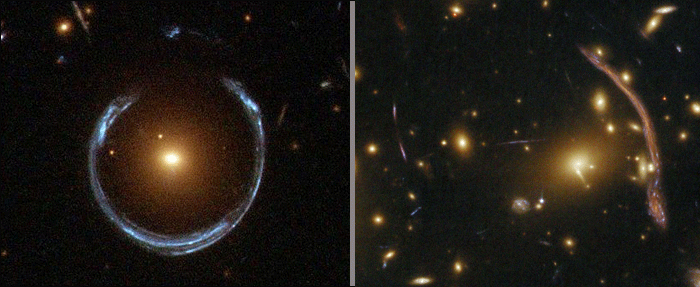
Gravity lensing is not new. Predicted by Albert Einstein, some excellent examples have been observed over small distances by the gravity of a single galaxy. Perfectly aligned, the furthest galaxy appears circular as light bends around LRG-757 [above left] in this Hubble Telescope image.
[right] A close up of the Abell galaxy cluster showing a dramatic example of the distortion from the lens effect. Rather than a symmetric blob, astronomers think that the dark matter cloud may be elongated with the orientation along our line of sight. In other words, we may be looking through the longest and thickest part of a filmanet of dark matter which would explain the magnified galaxies in the center of the "lens".
Dark Matter: What are the possibilities?
Whatever it is, the dark matter seems to be "aware" of the visible matter that we are familiar with. It collects and forms a cocoon, called the dark matter halo, that engulfs the galaxy, contributing to its total mass and allowing the movements of stars that have been observed. The halo is evenly distributed with no concentration in the galactic bulge. It does not seem to attract itself gravitationally as normal matter does. It doesn't clump together or concentrate. At least as much as we can detect presently.
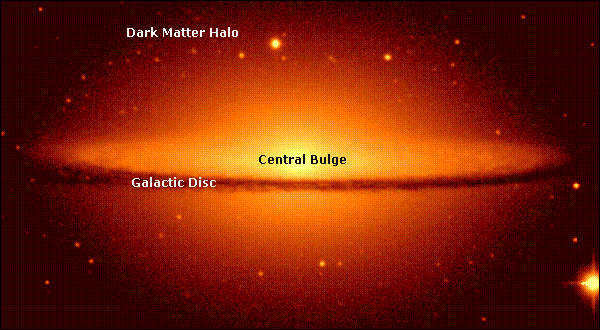
Dark matter isn't everywhere. It has been been detected gravitationally in regions of space that suggest it is distributed in enormous filaments, which later become the birthplace of stars.
There are some interesting theories about the structure of dark matter. Let's check it out.
WIMP v MACHO
When scientists describe "stuff" they usually speak of two possibilities. One idea is called Weakly Interactive Massive Particles (WIMPs). Without getting too complicated, WIMPs are similar to neutrinos which can pass right through the earth. Each square centimetre of the human body is traversed by 60 billion neutrinos per second. But WIMPs have a larger mass. WIMPs are thought to interact only in the spectrum of weak nuclear force -- incapable of any electromagnetic activity.
Although just a theory, particles believed to be WIMPs have been detected in underground chambers designed to measure the infinitesimal "bump" that occasionally happens when a WIMP hits an atom. This possibility -- that dark matter is a previously unknown particle -- seems the most promising. [See Particle May Be Leading Candidate for Mysterious Dark Matter]
MACHO is the acronym for Massively Compact Halo Objects, the rival theory for dark matter. It assumes that the invisible stuff is made of protons, neutrons and things we are familiar with -- atoms -- but the stuff has been compressed and cooked up in a special recipe, making the electrons (if they are still there) inaccessible for any outside interaction. MACHOs may possibly be black holes or neutron stars as well as brown dwarfs or unassociated planets. White dwarfs and very faint red dwarfs have also been proposed as candidate MACHOs.
Recently, there has been some criticism of this possibility because black holes, one of the potential MACHOs, are thought to produce a halo of bright gas and dust that forms around it as an accretion disc being pulled in by the black hole's gravity. Such a disk can generate jets of gas that are shot out away from the black hole because it cannot be absorbed quickly enough. We just don't see this. Also, as noted earlier, dark matter seems to be evenly distributed, almost homogenous.
|
Dark Matter Created Galaxy's Spirals
The Sagittarius Dwarf is a galaxy discovered in 1994. It is in a polar orbit (that is, in orbit over the north and south galactic poles) around our Milky Way galaxy. In 2003, infrared telescopes and supercomputers that traced the orbital motions of its stars has revealed that the Sagittarius Dwarf had actually collided with the Milky Way twice -- once 1.9 billion years ago and again 0.9 billion years ago -- and that it is now coming in for a third collision in just another 10 million years. Dwarf galaxies are composed of up to 99 percent dark matter and only one percent normal matter like stars. This disparity makes dwarf galaxies ideal targets for astronomers seeking to understand dark matter. [*] Published in September 15, 2011 issue of Nature Magazine, Dr. Chris W. Purcell, a postdoctoral research associate at the University of Pittsburgh, conducted a supercomputer simulations revealing that far more important than the Sagittarius Dwarf's stars in the collision, were its dark matter halo -- itself about equal in mass to all the stars in the Milky Way. Dr. Purcell believes this dark matter halo was what caused the spiral arms in our galaxy. [*]
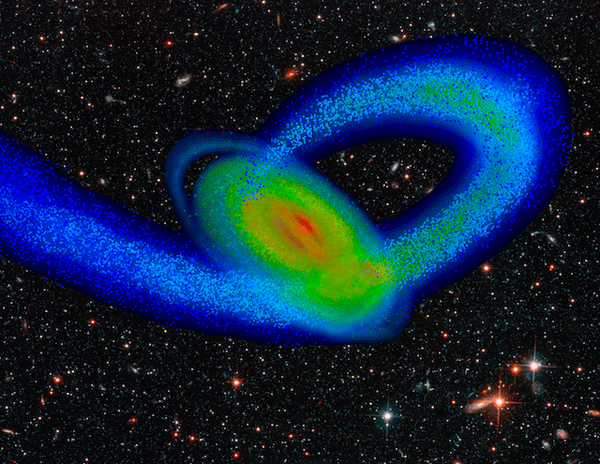
" The Sagittarius Dwarf impact triggered spiral arms in the Milky Way. When all that dark matter smacked into the Milky Way, 80 to 90 percent of it was stripped off... but the whirling disk of stars that was the Milky Way at this time was a very tenuous, chaotic system. That first impact produced instabilities that were amplified and quickly formed spiral arms and associated ring-like structures in the outskirts of our Galaxy." [Below: A very short animation of the collision between Sagittarius and the Milky Way, producing the spiral arms and showing the effect of dark matter's mass.]
|
A Hair on the Beard of the Creator
In addition to lurking in the halos of galaxies, dark matter appears to form scaffolding like filaments throughout the universe that become the home to new stars and galaxies.
 As reported in ScienceDaily [*], an observatory detected evidence of a filament made of dark matter, contributing to the idea that large galaxies are clustered together on structures similar to giant soap bubbles, with tinier galaxies sprinkled on the surface of this "soapy" layer.
As reported in ScienceDaily [*], an observatory detected evidence of a filament made of dark matter, contributing to the idea that large galaxies are clustered together on structures similar to giant soap bubbles, with tinier galaxies sprinkled on the surface of this "soapy" layer.
Observations from Tel Aviv University are giving new strength to this theory. A team led by Dr. Noah Brosch, Director of the Tel Aviv University-owned Wise Observatory, is the first in the world to uncover what they believe are visible traces of a "filament" of dark matter -- an entity on which galaxies meet, cluster and form. A filament can originate at the junction of two "soap bubbles," where the thin membrane is thicker.
Dr. Brosch, with his student Adi Zitrin and researchers from Cornell University, studied an area of the sky opposite the constellation Virgo, where 14 galaxies were forming in a line. Pundits have called the line a "Bridge to Nowhere" because it seems to start and end in unknown locations. Strangely, 13 of these galaxies were simultaneously giving birth to new stars.
The picture [right] shows the 14 galaxies studied at the Wise Observatory. The galaxies stretch along a line from the lower-right to the top-left corner of the image. The star-forming regions are highlighted as shining reddish points.
The odds of this occurrence are very rare, leading the researchers to believe that the galaxies might somehow be forming on this elusive filament, made entirely from dark matter, which attracts regular matter that then turns into new stars.
"There has long been a theoretical belief that this was the case, but this new finding represents experimental results that such a filament really exists, and that possibly it is an entity made from dark matter which is aligning these galaxies." -- Dr. Brosch
Dr. Brosch compares the work of astronomers who study dark matter to "looking for hairs of the beard of the Creator."
This line of galaxies may be one such hair. Generally speaking, matter as we know it on earth makes up only a small percentage of our universe. The composition of most of the universe is unknown -- it's either dark matter, about one quarter of the universe -- or dark energy, the other three-quarters. The known universe is just about 4.6% of what's out there.
Why it matters
Scientists who believe in the Big Bang theory of creation imagine an explosion which expands uniformly in all directions, like an expanding balloon. Measurements of all our neighbors show them receding away from us as the gap between everything and everything else gets bigger and expands faster.
Because all of this is happening to us in relatively slow motion, we don't much care about it. But to scientists who dream about these kinds of things, dark matter could mean that the universe will either stop eventually, then deflate and revert back to a singularity or the universe could continue to expand indefinitely, eternally and infinitely.

Before the introduction of dark matter in the equations, the universe looked like it would eventually collapse on itself. Total mass was based on the luminosities of stars and galaxies. Now, with this additional mass of the theoretical dark matter, plus something called dark energy, there may just be enough energy and matter to overcome the collapse. Scientists believe the universe is essentially flat and can expand indefinitely in all directions.
Good news for those who worry about such things.
COMMENTS:
I have always had trouble with the current theories about Dark Matter and/or Dark Energy because it is predicated upon the premise of the Big Bang.
Many of the problems associated with the Big Bang seem to be resolved by the theories of Plasma Cosmology. More importantly however, is a recognition of other states of matter known as ORME, (orbitally rearranged mono atomic elements). These states of matter involve high spin nuclei with electron shells that form cooper pairs with mesons within the nuclei of certain elements like precious metals, gold, platinum, iridium, etc.
In the high spin state these elements become super conductors and exhibit profound characteristics involving mass and gravity. These elements occur naturally but usually avoid detection because they don't interact with other elements in conventional physics.
We know that iridium is very common in the universe because meteor impacts show signs of high amounts of iridium as can be seen in the strata from an impact 65 million years ago from an event that is surmised to have caused the extinction of the dinosaurs.
Without recognizing the existence of these materials and their effect upon gravitation and mass any theory involving the mass of the universe is flawed and the theoretical creation of dark matter to account for missing mass is also flawed.
John P. Walliser
